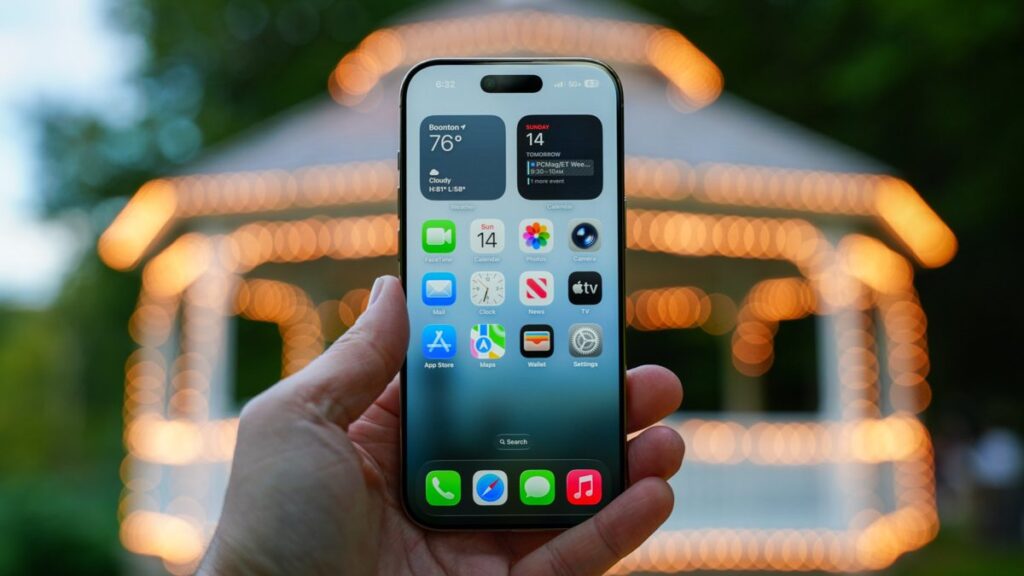
The $999 Apple iPhone Air, unveiled recently, is a remarkable piece of technology. Known for its ultra-slim design, this handset offers a vibrant display, decent battery life, and solid performance. However, it isn’t the fastest or longest-lasting model in the iPhone 17 lineup, and its single camera might be seen as a limitation by some. Despite these trade-offs, the iPhone Air stands out as one of Apple’s most intriguing releases in years. For those seeking a compact yet competent smartphone experience, the iPhone Air is worth considering. Meanwhile, the $799 iPhone 17 emerges as the Editors’ Choice due to its excellent screen, fast performance, and superior battery life, rivaling the more expensive Pro models.
Design: A New Benchmark in Slimness
The iPhone Air sets a new standard in smartphone design with its sleek profile. Reminiscent of the Samsung Galaxy S25 Edge, the iPhone Air is a reduced-size iteration of the iPhone 16 Plus, now part of the iPhone 17 series. Measuring just 0.22 inches in depth, excluding the camera plateau, the iPhone Air is breathtakingly thin. The camera plateau itself is a notable design shift, resembling Google’s Pixel phone modules with its horizontal bar and single lens, offering a clean and simple aesthetic.
In comparison, the Samsung Galaxy S25 Edge is slightly thicker at 0.23 inches, not including its camera module. The iPhone Air’s camera plateau increases its thickness to 0.45 inches, slightly more than the Galaxy’s 0.40 inches. Despite these measurements, the iPhone Air feels thinner due to its polished titanium frame and rounded edges, which blend seamlessly with Apple’s Ceramic Shield panels. This design choice significantly reduces the perceived thickness, making the phone feel lighter and more comfortable to handle.
Apple assures the durability of the iPhone Air, boasting its strength against physical stress. The phone is equipped with Apple’s Ceramic Shield 2, which is three times more scratch-resistant than its predecessor. Additionally, it holds an IP68 rating for dust and water resistance, a standard for flagship smartphones.
Display: Bright and Adaptable
The iPhone Air’s 6.5-inch display sits comfortably within the iPhone 17 lineup, flanked by the 6.3-inch iPhone 17 and 17 Pro, and the 6.9-inch 17 Pro Max. All models utilize OLED technology with a screen density of 460 pixels per inch, consistent brightness levels, and a ProMotion adaptive refresh rate ranging from 1Hz to 120Hz, supporting an always-on display feature.
During testing in various lighting conditions, the iPhone Air’s screen proved to be exceptionally bright and easy to view. It offers multiple modes for managing blue light, white balance, and accessibility features, enhancing usability across different environments.
Performance: Adequate, Yet Not Leading
The iPhone Air is powered by Apple’s A19 Pro processor, featuring a six-core CPU, a five-core GPU, and a 16-core Neural Engine. Although the Air shares the A19 Pro with the iPhone 17 Pro and Pro Max, it is the slowest in the lineup, particularly in GPU performance. This discrepancy may be attributed to thermal management, as the iPhone Air tends to heat up more than its counterparts during intensive tasks.
Despite these limitations, the iPhone Air remains competitive against other flagship devices. It outperforms Google’s Pixel 10 series but falls slightly behind Samsung’s Galaxy S25 series in benchmark tests. In practical terms, the iPhone Air handles multitasking and app management efficiently, though it heats up during resource-heavy activities like gaming and video editing.
Battery Life: A Mixed Bag
Apple does not disclose the exact battery capacity of its devices, but the iPhone Air is designed to maximize battery space within its slim frame. Apple’s estimates suggest up to 27 hours of video playback for locally stored content and 22 hours for streaming. In real-world testing, the iPhone Air lasted 19 hours and 15 minutes, which is shorter than the iPhone 17 and Pro models but better than some competitors like the Samsung Galaxy S25 Edge and Google Pixel 10 Pro.
Charging capabilities are consistent across the iPhone 17 lineup, with the Air supporting 30W wired charging and 20W wireless charging. When paired with Apple’s new variable-rate charger, the iPhone Air reaches a full charge in just 59 minutes.
Connectivity and Audio: Modern and Efficient
The iPhone Air features Apple’s second-generation C1x modem, supporting sub-6GHz 5G but not mmWave. In testing, the Air delivered impressive download and upload speeds, sufficient for most mobile applications. The device also integrates Bluetooth 6.0, Thread, and Wi-Fi 7 into a single N1 component, enhancing efficiency and performance.
Audio output is managed by a single speaker, a departure from the stereo setups of other iPhone models. Despite this, the speaker delivers clear and powerful sound, suitable for calls and media consumption. For a more immersive experience, Bluetooth earphones are recommended.
Camera: A Singular Focus
The iPhone Air’s single rear camera is a notable limitation compared to the dual and triple-camera setups of other iPhone 17 models. Despite this, the camera captures high-quality images with excellent color and detail. The front camera introduces a novel square sensor, allowing for versatile photo orientations and fields of view.
Video capabilities are robust, with support for 4K60 Dolby Vision footage, stabilized video, and various shooting modes. The Dual Capture feature, allowing simultaneous use of front and rear cameras, adds a creative dimension to video recording.
Software: iOS 26 Enhancements
The iPhone Air runs on iOS 26, featuring a refreshed design and new functionalities. Key updates include a redesigned messaging app, an improved camera interface, and expanded lock screen capabilities. The operating system also enhances Apple’s AI features, offering advanced tools for translation, visual search, and fitness tracking.
Apple’s commitment to software support ensures that the iPhone Air will receive updates for at least five years, maintaining its relevance and performance over time.
In conclusion, the iPhone Air is a compelling option for those prioritizing design and portability. While it may not lead in performance or battery life, its sleek form factor and robust features make it a standout in Apple’s lineup. For users seeking a more comprehensive experience, the iPhone 17 offers a balanced alternative with superior capabilities.







